INSTITUT SUPERIEUR D 'ANTHROPOLOGIE
INSTITUTE OF ANTHROPOLOGY
ONLINE COURSES / COURS A DISTANCE
SPRING TERM : APRIL 2014
REGISTER NOW
EGYPTE – 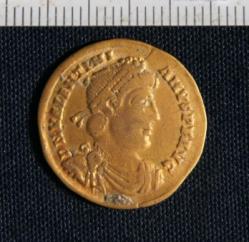
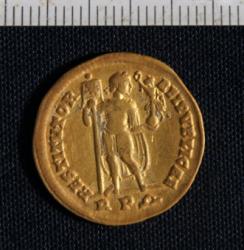 Deir el-Bakhit/Draâ Abu el-Naga - On March 22nd 2014, a hoard find of 29 Byzantine gold coins in almost pristine condition was discovered by the German Mission at Deir el-Bakhit/Draâ Abu el-Naga North in Western Thebes. The hoard consists of two different kinds of denominations: 18 are solidi, 11 are so called tremissis coins (equal one third of a solidus). The deposit was found in a Coptic chapel that was installed in a Pharaonic tomb. The coins were hidden in the shaft of a small sandstone column which served as a support of the altar which was set up in the chapel. The site (Winlock’ s unit XXVI) can be considered the earliest part of the monastery Deir el-Bakhit whose ancient name was a “monastery of St. Paulos”. Since the coins’ stamps show the Byzantine emperors Valentinian, Valens, Justin and Justinian, the deposit can be dated to the 5th to 6th centuries AD. The coins date the installation of the monastery’ s chapel to the same time. Until now, this chapel has to be regarded as the earliest monastic unit on the entire West Bank of Thebes. However, the coins do not only provide a close dating of the monastery, they also paint a vivid picture of the economic situation of the monastic community during the Late Antique period. The excavations in Deir el-Bakhit take place in cooperation between the Cairo department of the German Archaeological Institute (Dr. Daniel Polz), the Römisch-Germanisches Zentralmuseum Mainz (Dr. Ina Eichner) and the Ludwig-Maximilians-University Munich(Dr. Thomas Beckh), and are funded by the German Research Sociery (DFG).
Deir el-Bakhit/Draâ Abu el-Naga - On March 22nd 2014, a hoard find of 29 Byzantine gold coins in almost pristine condition was discovered by the German Mission at Deir el-Bakhit/Draâ Abu el-Naga North in Western Thebes. The hoard consists of two different kinds of denominations: 18 are solidi, 11 are so called tremissis coins (equal one third of a solidus). The deposit was found in a Coptic chapel that was installed in a Pharaonic tomb. The coins were hidden in the shaft of a small sandstone column which served as a support of the altar which was set up in the chapel. The site (Winlock’ s unit XXVI) can be considered the earliest part of the monastery Deir el-Bakhit whose ancient name was a “monastery of St. Paulos”. Since the coins’ stamps show the Byzantine emperors Valentinian, Valens, Justin and Justinian, the deposit can be dated to the 5th to 6th centuries AD. The coins date the installation of the monastery’ s chapel to the same time. Until now, this chapel has to be regarded as the earliest monastic unit on the entire West Bank of Thebes. However, the coins do not only provide a close dating of the monastery, they also paint a vivid picture of the economic situation of the monastic community during the Late Antique period. The excavations in Deir el-Bakhit take place in cooperation between the Cairo department of the German Archaeological Institute (Dr. Daniel Polz), the Römisch-Germanisches Zentralmuseum Mainz (Dr. Ina Eichner) and the Ludwig-Maximilians-University Munich(Dr. Thomas Beckh), and are funded by the German Research Sociery (DFG).
http://www.archaiologia.gr/en/blog/2014/03/27/byzantine-coin-hoard-found-in-deir-el-bakhit/
ROYAUME UNI – 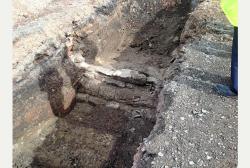 Leicester - Part of a medieval wall has been unearthed by archaeologists digging at De Montfort University. The 15th century structure is the boundary wall that once surrounded the Newarke area of the medieval city. Work to construct the nearby business and law building in the past few years had unearthed another part of the same wall. Rather than extracting the wall, it will be carefully reburied and preserved for future generations to rediscover. A spokesman for De Montfort University said: "It's a very interesting find but, as the archaeologists will tell you, not a surprising one because we know De Montfort University's campus is steeped in history dating from the 1300s." Stuart Bailey, of Leicester Civic Society, said it made sense to leave the wall in place. He said: "There's not much you can do otherwise except dig it up and have it in the wrong setting or abandon the building plans, which is what happened in the 1930s when the foundation walls next to Jewry Wall were first discovered. "The wall is made of stone and is very solid so it will survive long into the future. "I am sure it will be seen again." The Newarke was a religious precinct built in the 1400s as a college for priests on the edge of the city. It was surrounded by stone walls and had several stone buildings within its boundaries, including Trinity Hospital, which is now Trinity House. The Church of the Annunciation, where Richard III is believed to have been laid on public display after being killed at the Battle of Bosworth, also stood within the Newarke.
Leicester - Part of a medieval wall has been unearthed by archaeologists digging at De Montfort University. The 15th century structure is the boundary wall that once surrounded the Newarke area of the medieval city. Work to construct the nearby business and law building in the past few years had unearthed another part of the same wall. Rather than extracting the wall, it will be carefully reburied and preserved for future generations to rediscover. A spokesman for De Montfort University said: "It's a very interesting find but, as the archaeologists will tell you, not a surprising one because we know De Montfort University's campus is steeped in history dating from the 1300s." Stuart Bailey, of Leicester Civic Society, said it made sense to leave the wall in place. He said: "There's not much you can do otherwise except dig it up and have it in the wrong setting or abandon the building plans, which is what happened in the 1930s when the foundation walls next to Jewry Wall were first discovered. "The wall is made of stone and is very solid so it will survive long into the future. "I am sure it will be seen again." The Newarke was a religious precinct built in the 1400s as a college for priests on the edge of the city. It was surrounded by stone walls and had several stone buildings within its boundaries, including Trinity Hospital, which is now Trinity House. The Church of the Annunciation, where Richard III is believed to have been laid on public display after being killed at the Battle of Bosworth, also stood within the Newarke.
http://www.leicestermercury.co.uk/Leicester-archaeologists-uncover-14th-century/story-20857282-detail/story.html
ESPAGNE – 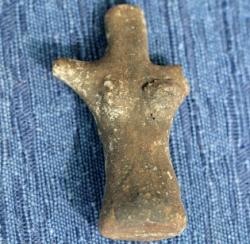 Estepona - Estepona Town Hall has agreed for the 5,000-year-old figure known as the ‘Venus of Estepona’ to become the town’s symbol. The figure is on show at the Municipal Archaeological Museum and is the only one of its kind found during archaeological digs in Malaga province. It is made of clay and was found in the Arroyo Enmedia area. It is believed to be an amulet or fertility symbol linked to rituals used in prehistoric times. It was found in August 2011 amongst other objects such as ceramic vases, arrowheads, stone axes, the parts of a necklace and other stone items. The ‘Venus’ is five centimetres tall and represents the female form in simple shapes with no physical details. However, the genital area is accentuated and so are the breasts.
Estepona - Estepona Town Hall has agreed for the 5,000-year-old figure known as the ‘Venus of Estepona’ to become the town’s symbol. The figure is on show at the Municipal Archaeological Museum and is the only one of its kind found during archaeological digs in Malaga province. It is made of clay and was found in the Arroyo Enmedia area. It is believed to be an amulet or fertility symbol linked to rituals used in prehistoric times. It was found in August 2011 amongst other objects such as ceramic vases, arrowheads, stone axes, the parts of a necklace and other stone items. The ‘Venus’ is five centimetres tall and represents the female form in simple shapes with no physical details. However, the genital area is accentuated and so are the breasts.
https://www.euroweeklynews.com/news/costa-del-sol/item/119570?
INDE -  Champhai - Mizoram has made an entry into India’s archaeological map. In a first, the Ministry of Culture has declared a 9,000 sq m area dotted with several caves, and more than a hundred menhirs embossed with figures of humans, animals and weapons as an ancient site of national importance. Some 170 menhirs, each at least as tall as a man, stand at the site at Champhai district’s Vangchhia village, which lies on the bank of the Tiau river that separates India and Myanmar. Villagers call the site “Kawtchhuah Ropui” (The Great Gateway) and have protected these monuments for years in spite of not being sure what they represent or how they came to be there. The Mizoram chapter of the Indian National Trust for Art and Cultural Heritage (INTACH) is hopeful that studies on the menhirs and the figures on them will shed more light on the history of the Mizos, much of which was never documented. The community followed an unwritten, oral tradition until a script was developed a little over a century ago. Menhirs with similar images have also been found in parts of eastern Mizoram including at Chawngtlai village near Khawzawl town and, according to Mizo historian B Lalthangliana, in the Chin Hills of Myanmar.
Champhai - Mizoram has made an entry into India’s archaeological map. In a first, the Ministry of Culture has declared a 9,000 sq m area dotted with several caves, and more than a hundred menhirs embossed with figures of humans, animals and weapons as an ancient site of national importance. Some 170 menhirs, each at least as tall as a man, stand at the site at Champhai district’s Vangchhia village, which lies on the bank of the Tiau river that separates India and Myanmar. Villagers call the site “Kawtchhuah Ropui” (The Great Gateway) and have protected these monuments for years in spite of not being sure what they represent or how they came to be there. The Mizoram chapter of the Indian National Trust for Art and Cultural Heritage (INTACH) is hopeful that studies on the menhirs and the figures on them will shed more light on the history of the Mizos, much of which was never documented. The community followed an unwritten, oral tradition until a script was developed a little over a century ago. Menhirs with similar images have also been found in parts of eastern Mizoram including at Chawngtlai village near Khawzawl town and, according to Mizo historian B Lalthangliana, in the Chin Hills of Myanmar.
http://indianexpress.com/article/india/india-others/field-of-menhirs-promises-to-shed-new-light-on-history-of-mizos/?
ROYAUME UNI – 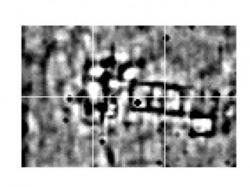 Plumpton - Archaeologists have mapped a Roman villa that has been hidden beneath the surface for hundreds of years. A team at Plumpton College has revealed new images of the villa that lies below the fields between the Downs and the Roman road that passes along the Greensand ridge. While the existence of the villa has been known about since the 1970s, the new geophysical survey carried out under supervision of archaeologist David Millum for the Sussex School of Archaeology has shown the extent of the building. The image captured by the survey shows a building of eight to nine rooms, around 40 metres wide and facing south with protruding wings at each end. The more intense readings to the western wing of the villa may indicate a heated room or a small bath suite. The school plans to undertake a week-long excavation training scheme
Plumpton - Archaeologists have mapped a Roman villa that has been hidden beneath the surface for hundreds of years. A team at Plumpton College has revealed new images of the villa that lies below the fields between the Downs and the Roman road that passes along the Greensand ridge. While the existence of the villa has been known about since the 1970s, the new geophysical survey carried out under supervision of archaeologist David Millum for the Sussex School of Archaeology has shown the extent of the building. The image captured by the survey shows a building of eight to nine rooms, around 40 metres wide and facing south with protruding wings at each end. The more intense readings to the western wing of the villa may indicate a heated room or a small bath suite. The school plans to undertake a week-long excavation training scheme
http://www.theargus.co.uk/news/11101096.Roman_villa_images_revealed_at_Plumpton_college/?ref=var_0
ROYAUME UNI – 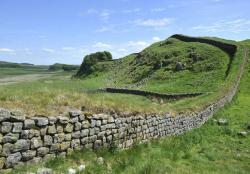 Hadrian’s Wall - The trust set up to manage Hadrian’s Wall is to close in six months after funding dried up, leaving support for the World Heritage Site “uncertain”. Hadrian’s Wall Trust revealed it is to close this week, with a series of organisations scrabbling to put funding in place to ensure one of Britain’s most famous monuments can be adequately maintained in the long term.
Hadrian’s Wall - The trust set up to manage Hadrian’s Wall is to close in six months after funding dried up, leaving support for the World Heritage Site “uncertain”. Hadrian’s Wall Trust revealed it is to close this week, with a series of organisations scrabbling to put funding in place to ensure one of Britain’s most famous monuments can be adequately maintained in the long term.
http://www.independent.co.uk/news/science/archaeology/hadrians-wall-trust-to-close-within-six-months-as-funding-evaporates-9215298.html
UKRAINE – 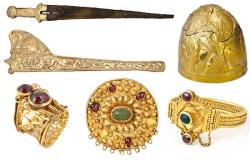 Crimee - Dutch museum faces dilemma whether to return artefacts to Ukraine or Russia. Scythian gold and other rare artefacts from Crimea on loan to an Amsterdam museum are in legal limbo after Russia’s annexation of the peninsula. The archaeological museum of the University of Amsterdam has asked the Dutch ministry of foreign affairs for advice and is consulting lawyers about the artefacts, which were due to return to Ukraine when a touring exhibition now at the Allard Pierson Museum closes.
Crimee - Dutch museum faces dilemma whether to return artefacts to Ukraine or Russia. Scythian gold and other rare artefacts from Crimea on loan to an Amsterdam museum are in legal limbo after Russia’s annexation of the peninsula. The archaeological museum of the University of Amsterdam has asked the Dutch ministry of foreign affairs for advice and is consulting lawyers about the artefacts, which were due to return to Ukraine when a touring exhibition now at the Allard Pierson Museum closes.
http://www.theartnewspaper.com/articles/Ancient-Crimean-gold-caught-in-legal-limbo/32122?
GRECE – 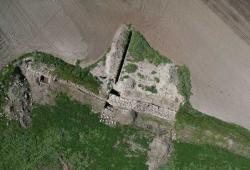 Kopais - The feat of the draining of the Kopais lake, which is echoed in myths and traditions surviving into historical times as one of the most impressive and ambitious achievements of Greek prehistory, had already provoked the interest of the academic community since the 19th century. Nevertheless, despite several investigations conducted in the area of the lake Kopais on quite a few occasions in the past, the detailed features of the Mycenaean draining system remained vague, since the expressed theories concerning its function and especially its precise dating within the Bronze Age, were based only on surface evidence and not on excavation data. It is this gap in the evidence that the latest systematic investigations in the north part of the lake intend to feel. The investigations are currently conducted under the direction of the speaker, in collaboration with the 9th Ephorate of Prehistoric and Classical Antiquities, the Department of Water Sources and Environment of the Athens Polytecnic and the Institute of Geography of the University of Mainz. The proposed functional model of the Mycenaean draining system is based on the emerging evidence, obtained through excavation in a number of areas as well as through an intensive surface and topographical survey of its course, effected with the help of new technologies and the available geospatial data for the wider area, in the context of the political reality of Mycenaean North Boeotia.
Kopais - The feat of the draining of the Kopais lake, which is echoed in myths and traditions surviving into historical times as one of the most impressive and ambitious achievements of Greek prehistory, had already provoked the interest of the academic community since the 19th century. Nevertheless, despite several investigations conducted in the area of the lake Kopais on quite a few occasions in the past, the detailed features of the Mycenaean draining system remained vague, since the expressed theories concerning its function and especially its precise dating within the Bronze Age, were based only on surface evidence and not on excavation data. It is this gap in the evidence that the latest systematic investigations in the north part of the lake intend to feel. The investigations are currently conducted under the direction of the speaker, in collaboration with the 9th Ephorate of Prehistoric and Classical Antiquities, the Department of Water Sources and Environment of the Athens Polytecnic and the Institute of Geography of the University of Mainz. The proposed functional model of the Mycenaean draining system is based on the emerging evidence, obtained through excavation in a number of areas as well as through an intensive surface and topographical survey of its course, effected with the help of new technologies and the available geospatial data for the wider area, in the context of the political reality of Mycenaean North Boeotia.
http://www.archaiologia.gr/en/